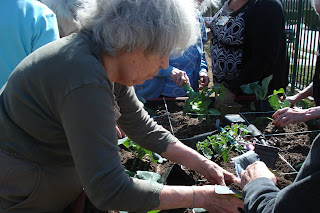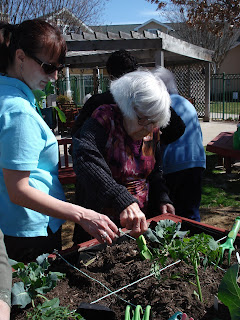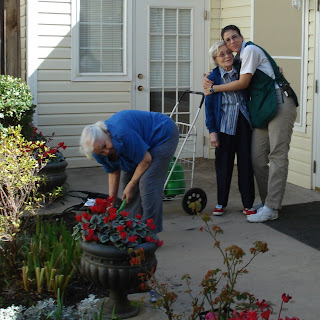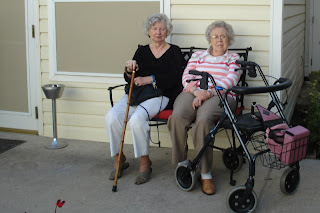Benefits of Dirt Therapy for Senior Citizens
We design Gardening programs for Seniors that meet the special needs of the specific Senior population we are working with. The physical, mental and emotional benefits of gardening activities may be slightly different when working with Memory Care residents compared to very able Independent seniors. But gardening is beneficial for Seniors of all ages and ability levels and is enjoyed by many Seniors.
We believe garden related activities and “enabled gardens” should be designed to be accessible to all. For example, raised garden beds, raised boxes, wall gardens, hanging plants and small individual containers can all be used in accessible Garden Therapy programs. We encourage Seniors with physical or cognitive limitations are to actively participate in planning and caring for the garden or their container plants so they feel a greater sense of accomplishment and ownership. For Memory Care residents, keeping projects simple and providing hand over hand instruction is important when helping them complete tasks independently.
Our Dirt Therapy activities are unique in that they use living materials requiring nurturing and care. The natural life cycle of plants provides participants with plenty of ongoing horticultural tasks and activities that stimulate thought and exercise and encourages an awareness of the seasons and the environment. This is especially important for Memory Care participants.
Gardening with Seniors in retirement facilities and communities is a very gratifying activity for all involved. A recent survey by the National Endowment for the Arts found that 63% of survey participants ages 65-74 and 53% of those ages 75-96 work with indoor plants or garden outdoors for pleasure. Another survey by the Roper Organization indicated that 33% of people 60 years or older are likely to say that gardening is an avid hobby or interest.
Our Dirt Therapy classes help retirement housing providers and health care administrators provide Senior residents with fun activities that improve quality of life and provide sensory and visual stimulation, social involvement, and healthy exercise. And as the Baby Boomer Generation ages, we believe the need for unique activities and horticultural therapy programs will continue to grow.
We believe gardening should be about getting dirty without feeling guilty, enjoying the results of a job well done and taking the time to soak up the sun and serenity that being in nature offers all of us.
Benefits of Garden Therapy include:
Improved Physical Functioning- Garden activities provide moderate exercise and builds fine motor skills by planting seeds or transplanting seedlings. Activities like digging and weeding improve gross motor skills. For those with limited mobility, even standing and working in raised beds provides an opportunity for good exercise.
Sensory Stimulation- Aging often involves loss or reduction of sensory capabilities so it becomes important to stimulate the senses that remain. Simple garden tasks improve hand-eye coordination and touching plants and smelling herbs and flowers can stimulate the senses and trigger happy memories from the past.
Improved Emotional Status- Garden projects and activities help build each participant’s self esteem and confidence as they are encouraged to make decisions and think creatively when completing personal projects. Working with plants fosters a sense of nurturing and purpose and these tasks and projects can often provide structure and activities that alleviate depression and alter negative feelings.
Social Skills- Garden programs provide an excellent opportunity for participants to interact with group leaders and other participants through sharing materials and creative ideas, assisting others with tasks, and sharing stories and memories of previous gardenling experiences with others.
Dirt Therapy classes at Silverado Senior Living in Plano, TX-
Silverado is a wonderful Memory Care Community that provides great care for
their residents. Recently we were able to get back to gardening thanks to a sunny early March day.
 |
| Planting late Winter veggies first week of March |
 |
| Miss G hard at work! |
 |
| Enjoying our afternoon in the sun! |
We had a great day planting one of our raised container beds this past week. Had a beautiful sunny 70 degree day in Dallas, and we enjoyed getting our Vitamin D the natural way!
Garden Club Class at Atria in Carrollton-
This is the second year for our Garden Club at Atria in Carrollton. Atria is a great Assisted Living facility and they have a beautiful courtyard for the residents to enjoy. We work in the flower beds and plant large containers and pots. This past week we planted some early Spring annuals and a few bulbs to liven up the courtyard. Some of the ladies were happy to soak up the sun and give moral support while others rolled up their sleeves and got some dirt under their fingernails!
 |
| Planting early Spring annuals |
 |
| Hard at work and getting hugs! |
 |
| Getting Vitamin D the natural way |
 |
| Happy just to supervise our work! |
We have a lot of garden classes schedule throughout the Spring so I'll share more of our progress as the growing season moves along.
Till next time- Put your hands in the earth and get ready for Spring!
Stephane
